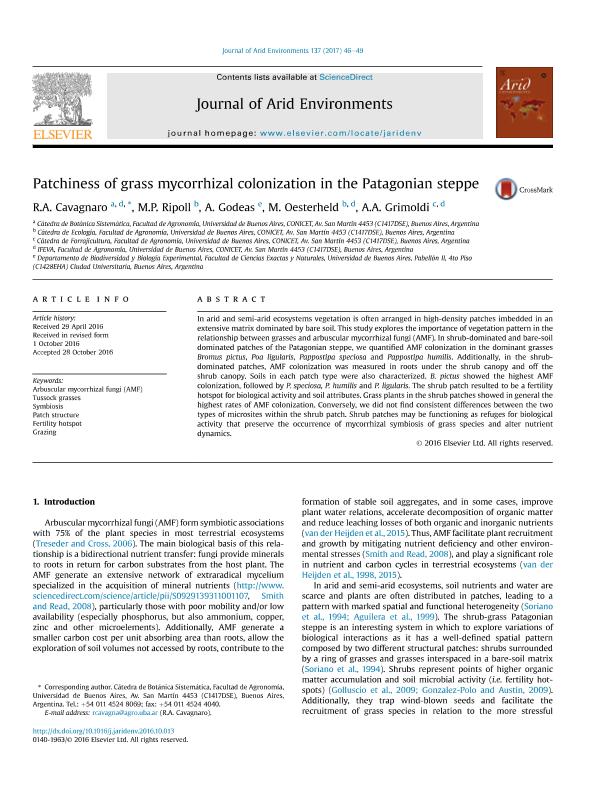Artículo
Patchiness of grass mycorrhizal colonization in the Patagonian steppe
Cavagnaro, Romina Andrea ; Ripoll, M. P.; Godeas, Alicia Margarita
; Ripoll, M. P.; Godeas, Alicia Margarita ; Oesterheld, Martin
; Oesterheld, Martin ; Grimoldi, Agustin Alberto
; Grimoldi, Agustin Alberto
 ; Ripoll, M. P.; Godeas, Alicia Margarita
; Ripoll, M. P.; Godeas, Alicia Margarita ; Oesterheld, Martin
; Oesterheld, Martin ; Grimoldi, Agustin Alberto
; Grimoldi, Agustin Alberto
Fecha de publicación:
02/2017
Editorial:
Academic Press Ltd - Elsevier Science Ltd
Revista:
Journal of Arid Environments
ISSN:
0140-1963
Idioma:
Inglés
Tipo de recurso:
Artículo publicado
Clasificación temática:
Resumen
In arid and semi-arid ecosystems vegetation is often arranged in high-density patches imbedded in an extensive matrix dominated by bare soil. This study explores the importance of vegetation pattern in the relationship between grasses and arbuscular mycorrhizal fungi (AMF). In shrub-dominated and bare-soil dominated patches of the Patagonian steppe, we quantified AMF colonization in the dominant grasses Bromus pictus, Poa ligularis, Pappostipa speciosa and Pappostipa humilis. Additionally, in the shrub-dominated patches, AMF colonization was measured in roots under the shrub canopy and off the shrub canopy. Soils in each patch type were also characterized. B. pictus showed the highest AMF colonization, followed by P. speciosa, P. humilis and P. ligularis. The shrub patch resulted to be a fertility hotspot for biological activity and soil attributes. Grass plants in the shrub patches showed in general the highest rates of AMF colonization. Conversely, we did not find consistent differences between the two types of microsites within the shrub patch. Shrub patches may be functioning as refuges for biological activity that preserve the occurrence of mycorrhizal symbiosis of grass species and alter nutrient dynamics.
Archivos asociados
Licencia
Identificadores
Colecciones
Articulos(IFEVA)
Articulos de INST.D/INV.FISIOLOGICAS Y ECO.VINCULADAS A L/AGRIC
Articulos de INST.D/INV.FISIOLOGICAS Y ECO.VINCULADAS A L/AGRIC
Citación
Cavagnaro, Romina Andrea; Ripoll, M. P.; Godeas, Alicia Margarita; Oesterheld, Martin; Grimoldi, Agustin Alberto; Patchiness of grass mycorrhizal colonization in the Patagonian steppe; Academic Press Ltd - Elsevier Science Ltd; Journal of Arid Environments; 137; 2-2017; 46-49
Compartir
Altmétricas



